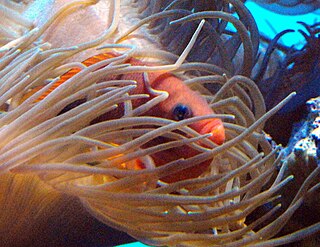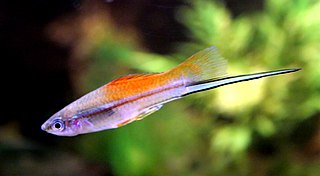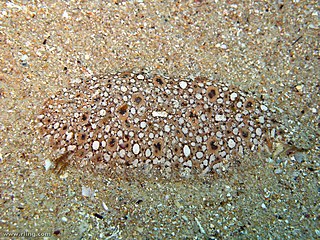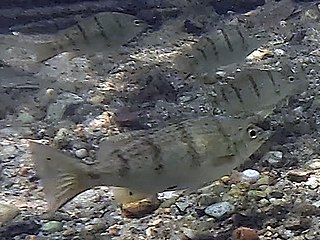
Amphiprion is a genus of ray-finned fish which comprises all but one of the species of clownfish or anemonefish in the subfamily Amphiprioninae of the family Pomacentridae.

Xiphophorus is a genus of euryhaline and freshwater fishes in the family Poeciliidae of order Cyprinodontiformes, native to Mexico and northern Central America. Xiphophorus species can be divided into 3 groups based on their evolutionary relationships: platyfish, northern swordtails, and southern swordtails. Platyfish formerly were classified in another genus, Platypoecilus, which is now obsolete. The type species is X. hellerii, the green swordtail. Like most other new world Poeciliids, platies and swordtails are live-bearers that use internal fertilization and give birth to live young instead of laying eggs like the bulk of the world's fishes. The name Xiphophorus derives from the Greek words ξίφος (dagger) and φόρος (bearer), referring to the gonopodium on the males. All are relatively small fishes, which reach a maximum length of 3.5–16 cm (1.4–6.3 in) depending on the exact species involved.

Lepidogalaxias salamandroides is a species of small freshwater fish of Western Australia. It is the only member of the family Lepidogalaxiidae and genus Lepidogalaxias. Common names for this fish include salamanderfish and Shannon mudminnow. Although it is not a lungfish, it resembles lungfish in several respects, including its ability to survive dry seasons by burrowing into the sand. It is on the IUCN Red List as Endangered.

Apistinae, the wasp scorpionfishes, is a subfamily of venomous, marine ray-finned fishes belonging to the family Scorpaenidae, the scorpionfishes and related species. These fishes are native to the Indian Ocean and the western Pacific Ocean.

Diplomystus is an extinct genus of freshwater and marine clupeomorph fish distantly related to modern-day extant herrings, anchovies, and sardines. It is known from the United States, China, and Lebanon from the Late Cretaceous to the middle Eocene. Many other clupeomorph species from around the world were also formerly placed in the genus, due to it being a former wastebasket taxon. It was among the last surviving members of the formerly-diverse order Ellimmichthyiformes, with only its close relative Guiclupea living for longer.
Cephalosilurus is a small genus of catfishes of the family Pseudopimelodidae. The genus was first described in 1911.

Ophisternon is a genus of swamp eels found in fresh and brackish waters in South and Southeast Asia, New Guinea, Australia, Middle America and West Africa. Two species are blind cave-dwellers.
Diabolepis is an extinct genus of very primitive marine lungfish which lived during the Early Devonian period. It contains a single species, D. speratus of Yunnan, China, from the mid-late Lochkovian of the Xitun Formation. It is one of the oldest known lungfish genera. It is the only member of the family Diabolepididae and the order Diabolepidiformes, although neither of these parent taxa have been officially described, despite their names being in scientific usage.

Jianghanichthys is an extinct genus of freshwater cypriniform fish from the Late Paleocene to Early Eocene of central and southern China, and the only member of the family Jianghanichthyidae. It is the oldest cypriniform fish known from body fossils, and the most basal known cypriniform.

Pseudobunocephalus is a genus of banjo catfishes.
Trachelyichthys is a genus of driftwood catfishes found in tropical South America.
Heptapterus is a genus of three-barbeled catfishes native to South America.
Variichthys is a genus of freshwater ray-finned fishes in the family Terapontidae from New Guinea and northern Australia. It was formerly known as Varia, but this name is preoccupied by a genus of moth.

An anchovy is a small, common forage fish of the family Engraulidae. Most species are found in marine waters, but several will enter brackish water, and some in South America are restricted to fresh water.

The Catostomidae are the suckers of the order Cypriniformes, with about 78 species in this family of freshwater fishes. The Catostomidae are almost exclusively native to North America. The only exceptions are Catostomus catostomus, found in both North America and Russia, and Myxocyprinus asiaticus found only in China. In the Ozarks they are a common food fish and a festival is held each year to celebrate them. The bigmouth buffalo, Ictiobus cyprinellus, can reach an age up to 127 years, making it the oldest known freshwater teleost by more than 50 years.

Pardachirus is a genus of soles mainly native to coastal water in the Indo-Pacific. A single species, P. poropterus is restricted to estuaries and lower sections of freshwater streams. At least some species in the genus are toxic.
The humpback waspfish,, is a species of wasp scorpionfish found only in the Gulf of Papua where it is an inhabitant of coral reefs. This species grows to a length of 15 centimetres (5.9 in) TL. This species is the only known member of its genus.

Lepidamia is a genus of fishes in the family Apogonidae, the cardinalfishes.

Amniataba is a genus of ray-finned fish in the family Terapontidae, that includes three species, with two being found in Oceania, and one in the Western Central Pacific.

Hephaestus is a genus of freshwater ray-finned fish, grunters from the family Terapontidae.














